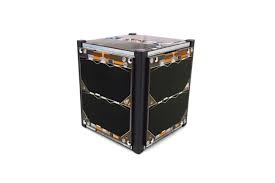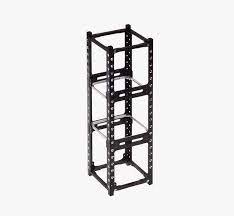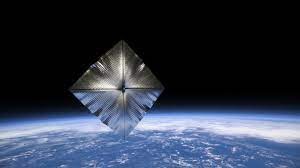The movie ‘Rocketry’ has given us a great insight into the professional life of rocket scientists in India. The development of the ‘Vikas Rocket Engine’ by the Indian Space Research Organisation (ISRO) is a great milestone. Lifting heavy payloads for interplanetary missions is a challenge for the nations in the launch vehicle business. However, a new trend has started in the production and launch of small satellites with standard dimensions of 10 centimetres and it is named as ‘Cube Satellites’. Any satellite weighing between 1 kg to 10 kg falls under the nanosatellite category. The majority of the cube satellites being fabricated and launched are nanosatellites and they need rocket engines consuming less fuel to take them to Low Earth Orbit (LEO). Many amateur players and universities are now getting into the business of cube satellites across the globe.

1U satellite (10x10x10 Cms)

3U frame (10X10X30 Cms)
ISRO had scripted history by successfully launching a record number of 104 satellites on 15 Feb 2017 with the help of a single rocket from the launchpad in Sriharikota. This is the highest number of satellites ever launched in a single mission and is a world record. Apart from satellite Cartosat – 2, all the other satellites were nanosatellites, of which 96 belonged to the USA. Antrix Corporation Limited (ACL) is a wholly owned subsidiary of ISRO under the Department of Space. ACL is the marketing arm of ISRO for the promotion and commercial exploitation of space products, technical consultancy services and transfer of technologies developed by ISRO. There is a huge opportunity waiting for ACL in the cube satellite space in coming years.
The ‘Cubesat’ concept has standardized the satellites and onboard systems. This standardisation and miniaturisation are helping the developing nations to venture into satellite missions at a lower cost. Technical universities and space startups around the globe are currently focussing on developing systems and technologies aiding nanosatellites. An average of 500 nanosatellite launches have been predicted for the year 2023 and 90% of these satellites would come under the nano category. These satellites once placed at LEO (200 – 2000 km height) would take roughly 90 minutes and 2 hours time to orbit the earth once.
Advantages
There are many advantages for Cubesats compared to the bigger ones. The satellites are very affordable and easy to assemble and construct. Commercially of the shelf (COTS), systems can be used for onboard avionic systems and energy requirements. Cubesats require less cost to get launched and need very less time for manufacturing and testing. In fact, ready-made kits are currently available in the market to purchase and assemble the satellites. Since the overall cost of production and launching is less, the risk of losing one satellite may not matter much. The satellite can be programmed to re-enter the earth’s atmosphere after the lifespan and can be burnt during the descent. The cost of fabrication and launch is coming down after every year and is becoming afordable for all developing nations to own.
Applications
A variety of applications have been explored and lined up for Cubesats. They are progressively taking over the applications of bigger satellites. The main constraint of Cubesat is the life span compared to the bigger satellites. Many agencies are currently working on extending the life of Cube satellites. Cubesats are now used for applications like remote sensing, imaging, earth observation, communications, surveillance, tethering at space, OTH communication, navigation conjoined with GPS, telemetry etc. This has become an ideal platform for testing and demonstrations. Universities and academia use them extensively for their research and studies. In fact, satellite services and applications will get democratised across the developing world in the coming years. Apart from the V/UHF bands, the satellites can communicate in S, C, X, Ku and Ka bands also. Optical communication links (100 Mbps to 1 Gbps) are also being used for downlinks and inter-planetary communication networks. Much-needed bandwidth requirements for downloading high-resolution imageries have been met by migrating to the optical spectrum.
Space Research
Testing and demonstration of applications specific to space is one area where Cubesat plays a leading role. Cost is the major factor here for short-listing Cubesat by space research agencies across the world. A wide range of applications like re-entry material testing, inspection of other satellites/ space stations, propulsion experiments, resolving temporal resolution, interplanetary missions, deep space exploration, and tracking other satellites are a few to be named.
Defence and Security applications
A variety of applications have been explored in the defence and security domain with the Cubesats. These include applications like tracking ballistic missiles, hypersonic missiles tracking, carrying space-based radar systems, data communication from remote battlefields/ oceans, weather warnings at remote places, target designation, damage assessment, operating in constellations or swarms, autonomous missile defence systems etc. Armed forces should take advantage of this opportunity since the cost benefits are huge compared to bigger satellites.
Energy and Propulsion
Power generation and management is one of the main constrain in extending the life of satellites, hence is applicable to Cubesats too. Life of the battery, size of the battery, energy-carrying capacity of the battery, power generated by the solar plant, energy distribution and management w.r.to the consumption of payload equipment, propulsion and movement in orbit post-launch are some major factors that could affect the overall life of Cubesats. The propulsion of these satellites between orbits is a challenge due to energy constraints. Propellant tanks with thrusters are to be inbuilt for intra-orbital movement. Solar sails are one of the best alternatives available for the movement of Cubesats after reaching orbit.

Solar Sail Propulsion PC; Techcrunch
Promising Future
There is a huge opportunity for our Antrix Corporation Limited (ACL) of ISRO to cash in and find resources for their future space endeavours. Every developing nation will be owning cube satellites in the coming years. Cubesats can also be hired for a much lower price compared to the bigger ones. Standardisation of satellite systems and miniaturisation of payloads have become a blessing to academia and universities to get into satellite research and studies. Assembling kits of satellites will become cheaper in the coming days. ‘Rocketry’ is getting more simplified.
Disclaimer: The views and opinions expressed by the author do not necessarily reflect the views of the Government of India and Defence Research and Studies
Title image courtesy: European Space Agency







